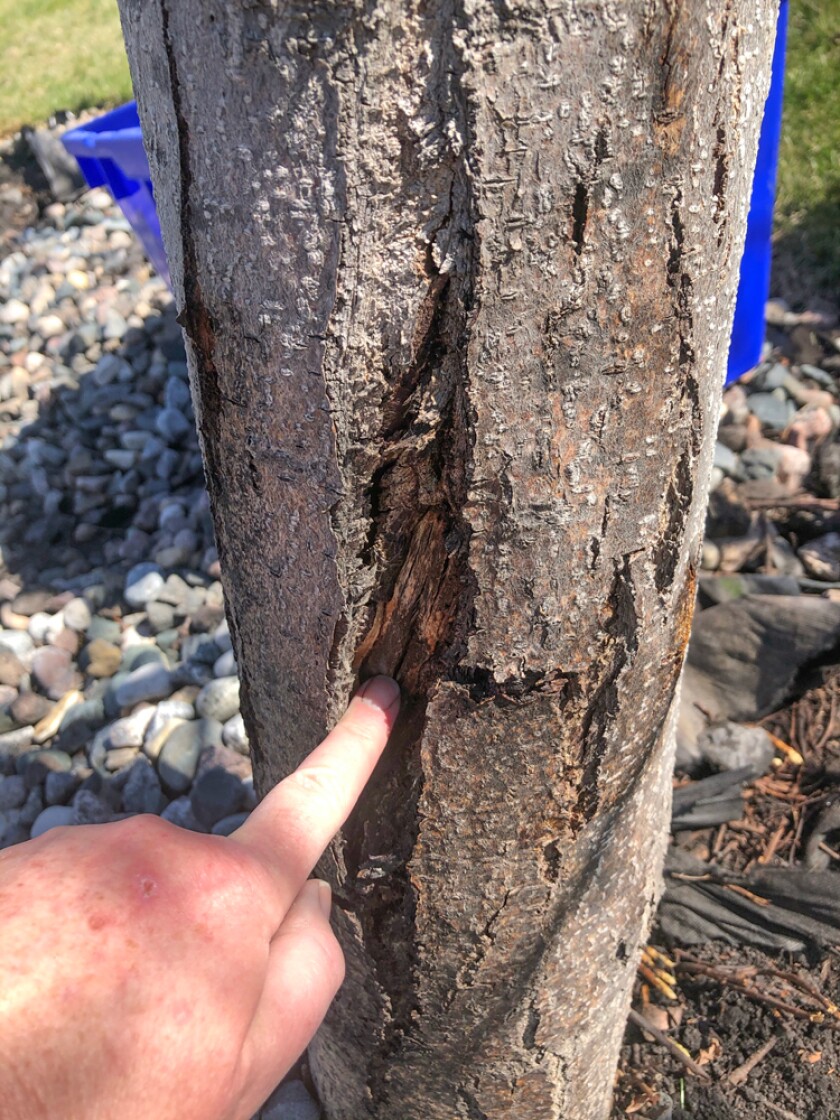Q: I have a love-hate relationship with a 20-year-old Canada Red Cherry tree that was planted in a rock island in my front yard. I am debating having it removed, because once the tree got to a certain age it started suckering badly. Suckers in the grass get taken care of by the mower, but those that pierce the landscape fabric and come up through the rock are unsightly.
It also has a 1-inch-deep frost crack in its trunk. Is the tree worth saving? We will only be in this home for another five years, and I am not sure I want to pass along a perpetual problem to the next homeowners. — Patti S.
ADVERTISEMENT
A: Given your battles with the suckers and the deep frost crack, I would vote for the tree's removal. The crack is a wound through which wood-rotting pathogens often get started, and the suckers can be a never-ending problem.
Some forms of Canada Red Cherry are grafted onto non-suckering rootstocks, but suckers are a major problem on many other types. Products like Sucker Stopper and Sucker Punch can be tried, following the label directions closely, but reviews are mixed.
If the tree has more negatives than positive, it might be time to remove it and start fresh. A good replacement might be one of the cultivars of Japanese Tree Lilac. They have beautiful puffs of white flowers, and the trees are generally problem-free, as long as they’re not planted in poorly drained locations.

RELATED COLUMNS:
-
North Dakota's evergreens are struggling
-
There's a better way than lawn weed-and-feed products
-
Lawn damage, the best trees for boulevards, and seeding lawns in spring
Q: I have a mature hydrangea shrub and have been reading in the seed catalogs about adding iron sulfate to acidify the soil to change the color of the blooms. The flowers are normally white or cream. Is it possible to change the flower color in our alkaline soil? If it is OK to do, is now the time to start adding this to the soil, or is it too early? — Morrie S.
ADVERTISEMENT
A: The types of hydrangeas that can be changed from blue to pink, or pink to blue, are not well-adapted to much of the Upper Midwest, especially from the Red River Valley region of Minnesota and North Dakota and westward. Hydrangea types that change color depending on soil acidity often belong to the species Hydrangea macrophylla, which is more closely related to the florist hydrangea.
The hydrangea types that grow so beautifully in North Dakota and Minnesota belong to the species Hydrangea arborescens and paniculata. Familiar to many are the large, rounded white flower clusters of Annabelle hydrangea and the pink tones of Vanilla Strawberry. These types are not dependent on soil pH for their color, and no amount of acidifying will make a change.
Acid-loving plants are difficult to grow in soils that are naturally alkaline. Trying to change soil pH from alkaline to acid is similar to trying to change the color of the ocean by adding food coloring.
RELATED COLUMNS:
Q: In reading . What’s the best way to find what the temperatures of our soils are? — Merrill P.
A: Special thermometers for soil can be purchased, but my favorite source of soil temperature data is from the North Dakota Agricultural Weather Network — NDAWN for short. Its online site lists current soil temperatures at 30 locations around the state at various depths which are updated hourly, and can be found at .
For each of the 30 locations, the chart shows soil temperatures in increments all the way down to 7 feet. The most useful depths to observe for lawn and garden purposes are 2, 4 and 8 inches.
ADVERTISEMENT
Soil temperature at the 2-inch level must reach 50 to 55 degrees for Kentucky bluegrass lawn seed to germinate. Tomato roots don’t begin to grow until the temperature in the root zone warms above 50 degrees at the 8-inch depth, and plants can languish if soil temperatures are below that point. Crabgrass seed begins germinating when the soil temperature at the 2-inch level approaches 50 degrees.
If you have a gardening or lawn care question, email Don Kinzler, NDSU Extension-Cass County, at donald.kinzler@ndsu.edu. Questions with broad appeal may be published, so please include your name, city and state for appropriate advice.













